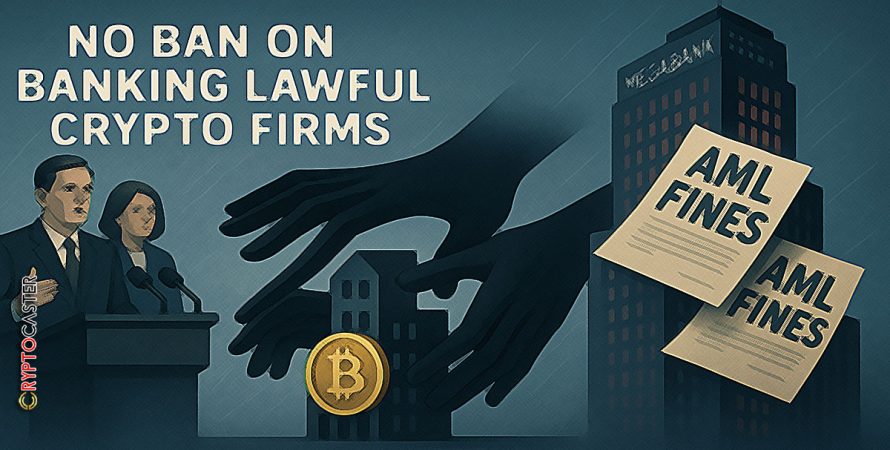U.S. officials say there’s no ban on banking lawful crypto firms. Yet a pattern of “de-risking” persists while megabanks caught in sweeping AML failures largely pay fines and move on. We unpack the record—and lay out fixes to end the double standard.
By CryptoCaster Editorial Board
Published: September 18, 2025
What Operation Choke Point actually was—and wasn’t
Operation Choke Point was a Department of Justice initiative circa 2013–2015 that pressured banks to scrutinize or sever ties with certain “high-risk” merchants. After congressional blowback, DOJ formally ended it in 2017 and stated it wouldn’t discourage banks from serving lawful industries. That history matters because some now describe a crypto-specific “Choke Point 2.0” as if it were a formal successor policy. It isn’t—and the original program was not an SEC creation.
Stay in the know on crypto by frequently visiting Crypto News Today
Policy vs. practice since 2023
After a turbulent 2022 for digital assets, the Federal Reserve, FDIC, and OCC issued risk bulletins about crypto-asset activities—liquidity, contagion, operational, and legal risks. Those same notices also said banks are neither prohibited nor discouraged from serving a class of lawful customers (including crypto firms).
In practice, many institutions still pulled back. That behavior—de-risking—is well documented across finance: banks reduce perceived regulator friction and reputational exposure by exiting entire customer categories rather than underwriting individual risk. Treasury’s own de-risking guidance warns that blanket cutoffs harm financial inclusion and push activity into the shadows. The message on paper is “risk-based, not category-based,” but the market often hears “don’t touch it.”
CryptoCaster Quick Check:
The enforcement gap people feel
Over the past decade, large banks implicated in serious AML failings have typically faced corporate settlements—deferred prosecution agreements, monitorships, and headline fines. Senior executives rarely see criminal exposure.
By contrast, several high-profile crypto cases have included individual-level charges alongside corporate penalties (e.g., exchange founders and CEOs facing BSA/AML counts). Even where the absolute dollar volumes at banks dwarf those in crypto, the mix of consequences often looks tougher on individuals in the digital-asset sector. That contrast fuels the perception of a double standard.
Is it really a double standard?
Legally, prosecutors have broad discretion in charging decisions. Historically, corporate-crime enforcement in banking has leaned on DPAs/NPAs and monitorships—tools designed to penalize the institution and reform controls without triggering collateral damage to the financial system. Critics argue this approach under-deters misconduct and entrenches a “too big to jail” dynamic.
Crypto, being newer, more founder-centric, and often operating outside traditional prudential supervision, presents clearer lines of individual responsibility—so prosecutors reach for individual charges more readily. The result can look less like technology-neutral enforcement and more like venue-dependent justice.
A tech-neutral fix (that doesn’t require a conspiracy)
1) Ban category bans; enforce risk-based banking. Make it binding—banks must evaluate customers individually. If risk is unacceptable, state the reason in writing and allow a remediation window.
2) Parity of accountability. Similar AML program failures should trigger a consistent mix of corporate penalties and responsible-person consequences—bank, exchange, or fintech partner—applied to the same thresholds of willfulness and repeat violations.
3) Sunlight on supervision. Publish anonymized metrics: crypto vs. non-crypto account closures, reasons cited, remediation outcomes, and the number of lifted consent orders each year. Sunlight narrows the space for informal pressure.
4) Clear, durable rules. Consolidate guidance on custody, stablecoins, and partner-bank models so firms aren’t reading tea leaves. Stability of rules discourages defensive de-risking.
5) Safe harbors for fixing problems. Offer time-boxed safe harbors for firms that self-identify AML gaps, fund independent remediation, and hit milestones—lose protection if they miss.
6) Emphasize effectiveness. Tie AML program expectations to outcomes (useful SARs, risk reduction) rather than checkbox formalism that nudges banks toward blanket exits.
The precise claim this piece makes
Before crypto—and still today—most illicit finance moves through fiat channels, especially the U.S. dollar and the traditional financial system. Crypto misuse is real and growing in specific niches (ransomware, sanctions evasion), but it remains a minority share of overall illicit flows. If that’s true, then equal, tech-neutral AML enforcement is not only fair—it’s essential to avoid pushing lawful innovation offshore while leaving legacy blind spots intact.
Bottom line: We don’t need a “new Choke Point” to protect the system. We need transparent, risk-based banking and parity in how corporate and individual accountability are applied—whether dollars move through a correspondent network or a matching engine.
If this article brought you clarity, insight, or value—support the work that made it possible.
At CryptoCaster, we report on Web3, crypto markets, and institutional finance with no billionaire owners, no shareholders, and no hidden agenda. While mainstream media bends toward Elon Musk, BlackRock, and JPMorgan narratives, we stay focused on what matters: truth, transparency, and the public interest.
We don’t just cover the headlines—we investigate the power structures behind them. From FTX and Ripple to the quiet push for CBDCs, we bring fearless reporting that isn’t filtered by corporate interests.
CryptoCaster is 100% paywall-free. Always has been. To keep it that way, we depend on readers like you.
If you believe independent crypto journalism matters, please contribute—starting at just $1 in Bitcoin or Ether. Wallet addresses are below.
Your support keeps us free, bold, and accountable to no one but you.
Thank you,
Kristin Steinbeck
Editor, CryptoCaster
Support CryptoCaster: The Unfolding of Money
At CryptoCaster.world, we’re dedicated to bold journalism, sharp insights, and fearless commentary across blockchain, Web3, and crypto markets. Your **Bitcoin contributions** help us stay independent and continue delivering signal over noise.
🚨 CryptoCaster does not offer investment advice. Always DYOR—volatility is real, and risk tolerance matters.
Support our mission. Contribute BTC today.
🔗 Bitcoin Address:
3NM7AAdxxaJ7jUhZ2nyfgcheWkrquvCzRm
Thank you for backing our journalistic lens as we chronicle the Unfolding of Money — a saga still being written in real time.![]()
CRYPTOCASTER HEATMAP







